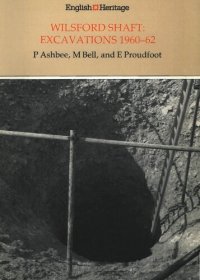
Ebook: Wilsford Shaft: Excavations 1960-2
- Genre: History // Archaeology
- Series: English Heritage Archaeological Reports 11
- Year: 1989
- Publisher: Historic Buildings & Monuments Commission for England
- City: London
- Language: English
- pdf
With contributions by A. David, G. W. Dimbleby, J. Evans, C. M. Grigson, S. V. E. Heal, R. E. M. Hedges, J. Henderson, G. Hendry, R. A. Housley, A. K. G. Jones, C. A. Keepax, P. J. Osborne, D. N. Pegler, V. B. Proudfoot, F. Raymond, M. Robinson, M. L. Ryder, J. P. Squirrell, M. Taylor, P. Tomlinson, E. C. Wallace, P. Walton, D. W. Yalden, and P. E. Yalden.
Ebook (PDF) published 2013.
The excavation of the presumed pond barrow, Wilsford 33a, in 1960, led to the baring of a weathering cone and the top of a shaft 6ft (1.8m) in diameter. Subsequent work during 1961 and 1962 revealed that is was of the order of 100ft (30m) in depth. At the bottom of the shaft waterlogging had preserved a range of objects and material in a manner not normally encountered upon the chalklands of Wiltshire. The remains of wooden containers and other wooden objects were discovered, accompanied by quantities of environmental material, domestic animal bones and fibres, small vertebrate remains, roundwood fragments, bud scales, insect remains, molluscs, pollen, seeds, fungi, moss, plant fibres, dung, and pieces of rope. The wide range of environmental evidence from the depths of the shaft provides the most detailed picture that we have at present of the natural history of a Bronze Age site. The conclusion to the report marks the different interpretations that have been reached in the light of the archaeological and environmental evidence.
Ebook (PDF) published 2013.
The excavation of the presumed pond barrow, Wilsford 33a, in 1960, led to the baring of a weathering cone and the top of a shaft 6ft (1.8m) in diameter. Subsequent work during 1961 and 1962 revealed that is was of the order of 100ft (30m) in depth. At the bottom of the shaft waterlogging had preserved a range of objects and material in a manner not normally encountered upon the chalklands of Wiltshire. The remains of wooden containers and other wooden objects were discovered, accompanied by quantities of environmental material, domestic animal bones and fibres, small vertebrate remains, roundwood fragments, bud scales, insect remains, molluscs, pollen, seeds, fungi, moss, plant fibres, dung, and pieces of rope. The wide range of environmental evidence from the depths of the shaft provides the most detailed picture that we have at present of the natural history of a Bronze Age site. The conclusion to the report marks the different interpretations that have been reached in the light of the archaeological and environmental evidence.
Download the book Wilsford Shaft: Excavations 1960-2 for free or read online
Continue reading on any device:

Last viewed books
Related books
{related-news}
Comments (0)